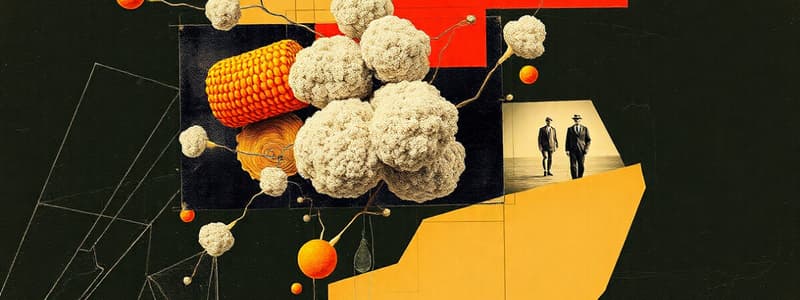Podcast
Questions and Answers
Which of the following sugars is considered a reducing sugar?
Which of the following sugars is considered a reducing sugar?
- Lactose (correct)
- All disaccharides are reducing sugars
- Maltose (correct)
- Sucrose
What is the main storage form of carbohydrates in human and animal bodies?
What is the main storage form of carbohydrates in human and animal bodies?
- Starch
- Lactulose
- Glycogen (correct)
- Cellulose
Which enzyme is responsible for digesting starch in humans?
Which enzyme is responsible for digesting starch in humans?
- Sucrase
- Amylase (correct)
- Lactase
- Cellulase
Cellulose primarily serves what function in plants?
Cellulose primarily serves what function in plants?
Which statement about lactose is true?
Which statement about lactose is true?
What distinguishes amylopectin from amylose in starch?
What distinguishes amylopectin from amylose in starch?
Which of the following is NOT a complex carbohydrate?
Which of the following is NOT a complex carbohydrate?
What is the primary role of carbohydrates in the body?
What is the primary role of carbohydrates in the body?
Which of the following is NOT a type of monosaccharide?
Which of the following is NOT a type of monosaccharide?
What term describes monosaccharides that differ in configuration around only one asymmetric carbon atom?
What term describes monosaccharides that differ in configuration around only one asymmetric carbon atom?
Which of the following statements about disaccharides is true?
Which of the following statements about disaccharides is true?
Sorbitol, a sugar alcohol, is formed from which process?
Sorbitol, a sugar alcohol, is formed from which process?
What type of sugar is formed by replacing a hydroxyl group with an amino group?
What type of sugar is formed by replacing a hydroxyl group with an amino group?
Which of the following is a characteristic of glucose?
Which of the following is a characteristic of glucose?
Which disaccharide is made up of glucose and fructose?
Which disaccharide is made up of glucose and fructose?
Study Notes
Carbohydrates
- Carbohydrates are organic molecules made up of carbon, hydrogen, and oxygen.
- They are essential for energy production, storage, and carbon supply for protein and fat synthesis.
- Carbohydrates also play a role in the structure of nucleic acids like DNA and RNA.
Monosaccharides
- Simple carbohydrates with polyhydroxy aldehydes or ketones, with the formula (C-H2-O)n.
- Examples include trioses (three carbons), tetroses (four carbons), pentoses (five carbons), and hexoses (six carbons).
- Classified as aldoses or ketoses based on their functional group (aldehyde or ketone).
Stereoisomers
- Molecules with the same chemical formula but differing in the position of hydroxyl groups on asymmetric carbons.
- Enantiomers are mirror images of each other (e.g., D-glucose and L-glucose).
- Epimers differ in the position of only one hydroxyl group on an asymmetric carbon (e.g., D-glucose and D-galactose).
Cyclization of Monosaccharides
- Monosaccharides can form ring structures through a reaction between the aldehyde or ketone group and a hydroxyl group within the molecule.
- This process creates anomeric carbons, which are essential for glycosidic bond formation.
Sugar Derivatives
- Sugar alcohols are formed by reducing the aldehyde or ketone group to a hydroxyl group (e.g., sorbitol). Excess glucose can lead to sorbitol accumulation, causing issues like cataracts and neuropathy.
- Sugar acids are created by oxidizing the aldehyde group or terminal carbon hydroxyl to a carboxylic group (e.g., gluconic acid and glucuronic acid). Glucuronic acid plays a role in drug metabolism through conjugation.
- Amino sugars are formed by replacing the OH group on the third carbon with an amino group (e.g., glucosamine).
Disaccharides
- Formed by combining two monosaccharides through glycosidic bonds.
- Important examples include lactose (galactose + glucose), sucrose (glucose + fructose), maltose (glucose + glucose), and lactulose (galactose + fructose).
- Lactulose is a synthetic disaccharide used as a laxative and ammonia removal agent from the gastrointestinal tract.
Reducing Sugars
- Sugars with a free anomeric carbon can act as reducing agents, causing the reduction and color change of Benedict's or Fehling's reagent.
- This property is used to diagnose the presence of glucose in diabetic patients and lactose in lactating women's urine.
Reducing and Non-Reducing Sugars
- All monosaccharides are reducing sugars.
- All disaccharides except sucrose are reducing sugars.
- Oligo- and polysaccharides are typically non-reducing sugars.
Simple (Homo) Polysaccharides
- Glycogen is a branched polysaccharide of glucose units, primarily stored in the liver and skeletal muscles. It serves as the main carbohydrate storage for the body.
- Starch is a glucose polymer found in plants, a major source of dietary carbohydrates. It consists of amylose (linear) and amylopectin (branched) molecules.
- Both glycogen and amylopectin are branched chain polysaccharides, with glucose molecules linked by a (1 - 4) linkages and branches connected by a (1 - 6) linkages.
- Humans and animals can digest starch through the hydrolysis of amylose and amylopectin by the enzyme amylase.
Cellulose
- A structural polysaccharide found in plants, primarily responsible for their rigidity and cell walls.
- Most animals, including humans, cannot digest cellulose due to the absence of the necessary enzymes.
- Exceptions include some herbivores and certain gut bacteria.
Complex (Hetero) Carbohydrates
- Carbohydrates can be linked to non-carbohydrate molecules through glycosidic bonds.
- Examples:
- Purines and pyrimidines in nucleotides of nucleic acids
- Proteins in glycoproteins and proteoglycans
- Lipids in glycolipids
Studying That Suits You
Use AI to generate personalized quizzes and flashcards to suit your learning preferences.
Related Documents
Description
Test your knowledge on carbohydrates, their structures, and the classification of monosaccharides. This quiz covers essential concepts like stereoisomers and the cyclization of monosaccharides, helping you understand their importance in biological systems.




